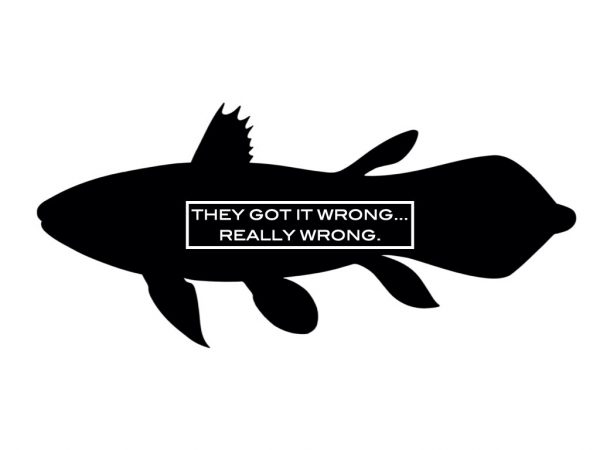The “story” played out so well and it “seemed” plausible—and also, it plugged a major hole in their theory. So, they went with it…big time. For years the coelacanth, a lobed-finned fish, was touted as the creature that took us out of the water onto the land, eventually giving rise to the dinosaurs. It was allegedly the ancestor of all modern land-dwelling tertrapods (four-footed animals).
Prior to 1938, the coelacanth was known only from fossils, which afforded scientists a great deal of speculation when they tried to extrapolate a physiology from the record of the rocks. Certain structures, such as fins, were determined to be the forerunners of legs for all amphibians. With joy abounding, evolutionists designated this as the animal that allowed fish to crawl out of the muck and mire in order to live on dry land.
Textbooks were quick to point out this “missing link” as a transitional animal between water-dwelling and land-dwelling creatures. For instance, one book explains “The coelacanth is the only surviving member of the ancient group of fishes from which modern four-footed land animals are thought to have evolved” (Maton, et al., 1997, p. 105). Another biology textbook has a beautiful picture of this amazing creation with the following caption:
“The living coelacanth, Latimeria chalumnae. Discovered in the western Indian Ocean in 1938, this coelacanth represents a group of fishes that had been thought to be extinct for about 70 million years. Scientists who studied living individuals in their natural habitat at depths of 100 to 200 meters observed them drifting in the current and hunting other fishes at night. Some individuals are nearly 3 meters long; they have a slender, fat-filled swim bladder. Although Latimeria is a very strange animal, its features mark it as a member of the evolutionary line that gave rise to the terrestrial tetrapods” (Raven and Johnson, 1989, p. 857).
It seemed a good fit at the time. The funny looking creature with lobed front fins appeared to be the perfect candidate for evolutionists’ transitional creature. Yet, the truth has shown this to be completely wrong.
In December 1938, a living coelacanth was caught off the coast of Africa, and soon thereafter the evolutionists’ joy turned to consternation when it was determined that the soft anatomy of the coelacanth was nothing like that of an amphibian. A 1999 book review in Nature provided the following commentary regarding the anatomy of coelacanths:
“…it shares very few advanced characteristics with the tetrapods, and this puts it somewhere near the base of the sarcopterygian [vertebrates in which the fin/limbs portion of the skeleton articulates to the girdles by means of a single bone—BH] tree. In a sense, the coelacanth tells us more about the primitive condition of all bony fishes than about the origin of tetrapods” (Janvier, p. 856).
Fast-forward to 2021, when the demand for shark fins prompted fishermen to take their nets deeper. Tony Carnie reported, “a new commercial market in China for shark fins and oil prompted fishers off the southwest coast of Madagascar to set large-mesh gill-nets known as jarifa in deeper waters: a startling number of coelacanths have been landed as by-catch.” Carnie pointed out that this new discovery had recently been published in the South African Journal of Science. In that journal article researchers Andrew Cooke, Michael Bruton and Minosoa Ravololoharinjara reported that many Coelacanths have also been captured off the coast of Madagascar.
Bob Yirka, writing for Phys.Org noted, “The work involved studying catch records made by fishermen, most of whom were using a type of gillnet known as jarifa—they are used to capture sharks in deep water. The nets are placed vertically in the water down to depths of 300 meters in underwater canyons—the same places where coelacanths live. The researchers found far more recorded captures than they were expecting—34 between the years 1987 and 2019, enough to suggest that as many of 100 of them may have actually been captured over the past several decades.”
These and other studies have made it quite apparent that these fish did not live in shallow areas “ready to crawl out onto land.” All the way back in 1998, Peter Forey observed, “Comoran coelacanths live at about 180 meters, below the 18° C isotherm, and inhabit submarine caves formed through recent volcanic activity” (1998, 395:319). These animals, that allegedly were suppose to have crawled out on land, are extremely deep-water fish. Evolutionists got it wrong—these are not fish that lived millions of years ago that walked out on land, and gave rise to the dinosaurs. No, these are fish that live in tremendously deep waters, and they are very much alive today.
REFERENCES
Carnie, Tony (2021), “Ghost fish: after 420 million years in the deeps, modern gillnets from shark fin trade drag coelacanths into the light,” Mongabay News, Online https://news.mongabay.com/2021/05/ghost-fish-after-420-million-years-in-the-deeps-modern-gillnets-from-shark-fin-trade-drag-coelacanths-into-the-light/
Forey, Peter (1998), “A Home From Home for Coelacanths,” Nature, 395:319-320, September 24.
Janvier, Philippe (1999), “Coleacanth a’ la Marseillaise,” Nature, 401:854-856, October 28.
Maton, Anthea, Jean Hopkins, Susan Johnson, David LaHart, Maryanna Quon Warner, and Jill D. Wright (1997), Exploring Life Science (Upper Saddle River, NJ: Prentice Hall), second edition.
Raven, Peter H. and George B. Johnson (1989), Biology (St. Louis, MO: Times Mirror/Mosby College Publishing), second edition.
Yirka, Bob (2021), Advent of gillnets has led to significant numbers of coelacanth captures, May 24th, https://phys.org/news/2021-05-advent-gillnets-significant-coelacanth-captures.html.

Dr. Brad Harrub is the director and co-founder of Focus Press. He has authored and co-authored numerous books, including “Convicted,” “Engage,” and “Heart of the Matter.” Brad and his wife, Melinda, and their children Will, Reese, Claire, and Luke reside in Franklin, TN. You can find his full bio here.








